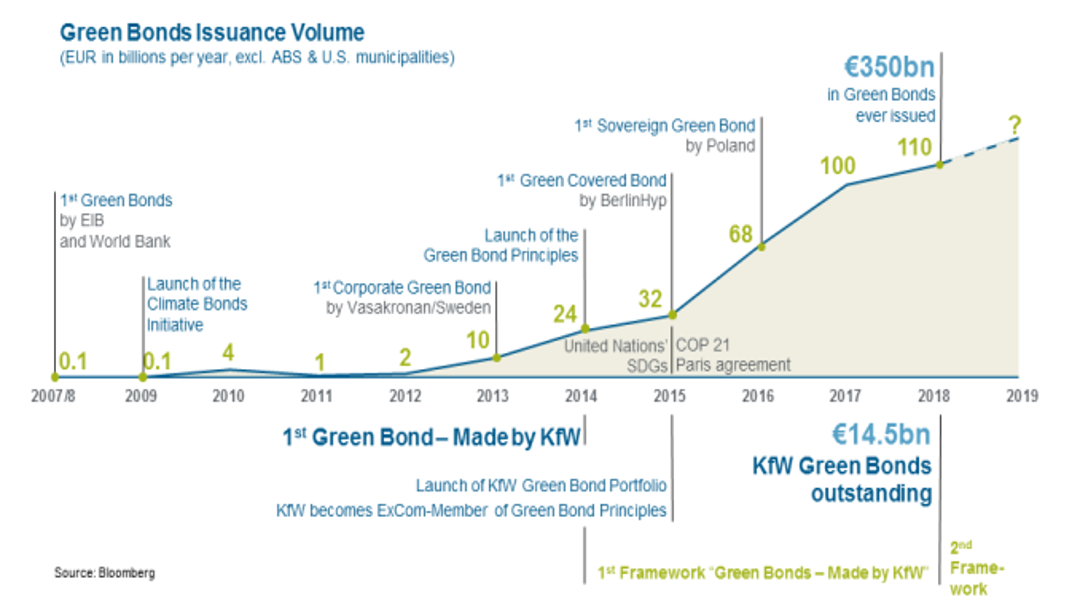News from 2019-07-24 / Group, Investor Relations, Sustainability
5th year anniversary of KfW's Green Bond Programme
This week, the very first “Green Bond – Made by KfW” matured which is an opportunity to look back on the development of KfW’s Green Bonds within the last five years as well as to highlight the current status of KfW’s green funding programme. On 22 June 2014, the first EUR 1.5 billion "Green Bond - Made by KfW" marked the start of a successful funding programme which has grown continuously over the last five years.
The very first “Green Bond – Made by KfW”
„This issuance clearly shows that we hit the mark with our sustainable investment offering – our first Green Bond is a huge success. Especially the high degree of transparency and the unprecedented quality standards of our green bond concept convinced the investors”, commented Dr Günther Bräunig, today CEO of KfW Group, on the issuance day of the first “Green Bond – Made by KfW”.
Transparency was not the only distinctive feature of this bond, though, as it was also the largest green bond ever issued at the time allowing KfW to play a pioneer role in the integration of sustainability in the capital market. The bond’s outstanding quality was recognized by the International Financing Review (IFR) with the “SRI Bond of the year 2014” award. Oversubscribed by more than EUR 1 billion, the order book registered 146 investors in this comparatively young market segment. While the bulk of investors came from Europe (76%), there were also investors from Asia (19%) and other continents (5%). In this transaction, fund and asset managers accounted for half of the order book, with banks (17%) coming second and central banks (14%) third.
A bond with positive environmental impact
The opportunity to combine investments in environmental and climate protection with the liquidity and safety of KfW bonds is the key characteristic of “Green Bonds – Made by KfW”. Under KfW’s first Green Bond framework, net proceeds from the bonds were exclusively dedicated to projects financed under KfW’s “Renewable Energies – Standard” loan programme, with which KfW aims to promote, for example, investments in wind turbines, hydro energy and photovoltaics. The impact of this first bond was independently evaluated by ZSW (Center for Solar Energy and Hydrogen Research Baden-Württemberg).
According to this evaluation, an investment in the EUR 1.5 billion Green Bond in 2014 lead to 1.3 million tons of GHG emission reductions per annum (CO2-equivalents)*. An amount that is equal to the emissions of around 670,000 passenger cars in one year. To use graphic terms: Over 105 million trees would need to be planted to compensate 1.3 million tons of GHG emissions. In addition, the projects financed with the Green Bond’s proceeds generate renewable energy of 1.8 million MWh p.a., enough to power almost 566,000 German households. Besides these impacts, the projects also add renewable energy capacity, create jobs and save external costs.
The development of KfW’s Green Bond programme
Since this landmark transaction, the German promotional bank has continuously been expanding its programme. Today, there are 27 “Green Bonds – Made by KfW” totalling EUR 19.2 billion in five different currencies (EUR, USD, GBP, SEK and AUD). Making use of its position as an active issuer of green bonds, KfW has played a key role in the market development to support the trend towards more sustainable investments. Since 2015, the bank has been a member of the Executive Committee (ExCom) of the Green Bond Principles which constitute voluntary standards for the use of proceeds, project evaluation and management of proceeds as well as reporting of green bonds. Furthermore, KfW strives to promote sustainability by initiating dialogue with all stakeholders involved in the process of issuing green bonds.
Especially apparent is the significant growth of the green bond market since 2012, as the annual issuance volume has more than quadrupled during the last five years. KfW has been one of the major issuers in the green bond market since its first issuance in 2014.

In response to the growing demand, KfW extended its Green Bond framework in May 2019. Besides providing funds for projects in the renewable energy sector, the proceeds will now also be used for the “Energy-efficient Construction” programme. Thus, a second standardised loan programme that makes a measurable contribution to climate action and generates substantial volume, is financed by “Green Bonds – Made by KfW”.
In the last two months, KfW has already issued four bonds in four different currencies with a total volume of EUR 4.7 million under the new framework. The start made a bond worth EUR 3 billion – the order book in this case was oversubscribed by more than EUR 8 billion, which is testimony of the very strong global demand for KfW Green Bonds. This transaction also was the largest Green Bond ever issued by KfW as well as the largest green bond ever issued by any non-sovereign SSA issuer to date. Two weeks later, the bank issued its largest to date SEK Green Bond. The SEK 7 billion Green Bond was bought mainly by pension funds (60%) in Scandinavia. The third one was an AUD 450 million bond opening a new line in this currency – a pleasing return to the green “kangaroo” market. With its latest GBP 650 million transaction KfW entered again the green Sterling market.
The extension of its Green Bond framework enables KfW to offer liquid green bonds on a regular basis. While KfW’s green issuance volume had been between EUR 2 billion and EUR 4 billion a year so far, KfW intends to clearly enlarge this with its extend framework.
*figures relating to the impact are based on KfW’s financing share.


Share page
To share the content of this page with your network, click on one of the icons below.
Note on data protection: When you share content, your personal data is transferred to the selected network.
Data protection
Alternatively, you can also copy the short link: kfw.de/s/enkBbm2u.CCJA
Copy link Link copied